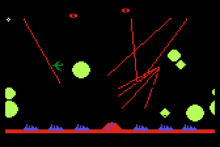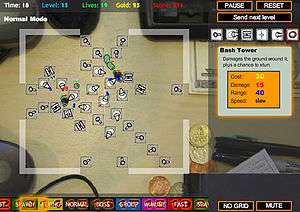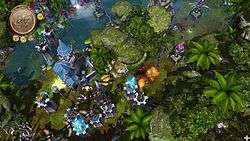Tower defense
Tower defense (or informally TD) is a subgenre of strategy video game where the goal is to defend a player's territories or possessions by obstructing enemy attackers, usually achieved by placing defensive structures on or along their path of attack.[1] This typically means building a variety of different structures that serve to automatically block, impede, attack or destroy enemies. Tower defense is seen as a subgenre of real-time strategy video games, due to its real-time origins,[2][3] though many modern tower defense games include aspects of turn-based strategy. Strategic choice and positioning of defensive elements is an essential strategy of the genre.
History
Precursors



The tower defense genre can trace its lineage back to the golden age of arcade video games in the 1980s. The object of the arcade game Space Invaders released in 1978 was to defend the player's territory (represented by the bottom of the screen) against waves of incoming enemies. The game featured shields which could be used to strategically, to obstruct enemy attacks on the player and assist the player to defend their territory, though not specifically to protect the territory. The 1980 game Missile Command changed that by introducing a strategy element. In the game, players could obstruct incoming missiles, and there were multiple attack paths in each attack wave.[4] Missile Command was also the first of its kind to make use of a pointing device, a trackball, enabling players to use a crosshair. The innovation was ahead of its time and anticipated the genre's later boom, which was paved by the wide adoption of the computer mouse. Additionally, in Missile Command, the sole target of the attackers is the base, not a specific player character. For these reasons, some regard it as the first true game in the genre.[4]
While later arcade games like Defender (1981) and Choplifter (1982) lacked the strategy element of Missile Command, they began a trend of games that shifted the primary objective to defending non-player items. In these games, defending non-players from waves of attackers is key to progressing. Atari's 1982 title Star Wars: The Empire Strikes Back was one of the first tie-ins to popularize the base defense style. The concept of waves of enemies attacking the base in single file (in this case AT-ATs) proved a formula that was subsequently copied by many games as the shift from arcade to PC gaming began. Players were now able to choose from different methods of obstructing attackers' progress.[5] By the mid 1980s, the strategy elements began to further evolve. Titles like Imagine Software's 1984 release Pedro mixed the player's abilities to actively defend and obstruct waves of different enemy types, including fixed obstructions, as well as the ability to build and repair a player's territory.[6]
Modern genre emerges
Rampart, released in 1990 is generally considered to have established the prototypical tower defense.[7] Rampart introduced player placed defenses that automatically attack incoming enemies. In addition, it has distinct phases of build, defend and repair. These are now staple gameplay elements of many games in the genre. It was also one of the first multiplayer video games of its kind.[8]
While Rampart was popular, similar games were rarely seen until the widespread adoption of the computer mouse on the PC. The DOS title Ambush at Sorinor (1993) was a rare exception from this era.[8] Tower defense gameplay was also rarely seen on consoles, a notable exception being the minigame Fort Condor from the popular 1997 title Final Fantasy VII, which was also one of the first to feature 3D graphics. As Real Time Strategy games gained popularity in PC gaming, many introduced tower defense modes in their gameplay, particularly in multiplayer modes. The 2006 mods Element Tower Defense (Element TD) and Gem Tower Defense released in February for the popular RTS title Warcraft III: Reign of Chaos almost single-handedly rekindled the genre.[7] These titles would also bring Role Playing Game elements to the genre for the first time.
2007-2008 boom
Between 2007 and 2008, the genre became a phenomenon, due in part to the popularity of the tower defense mode in real time strategy games, but mainly due to the rise of Adobe Flash independent developers as well as the emergence of major smartphone app stores from Apple and Google. The first stand-alone browser games emerged in 2007.[9] Among them were the extremely popular titles Flash Element Tower Defense released in January[10] and Desktop Tower Defense released in March.[11][12] Desktop Tower Defense earned an Independent Games Festival award,[13] and its success led to a version created for the mobile phone by a different developer.[14] Another significant Flash title released in 2008 was GemCraft.[15] Handheld game console were not ignored in the boom and titles included Lock's Quest and Ninjatown released in September and October respectively.[16]
With the arrival of Apple's App Store tower defense developers adapted quickly to the touchscreen interface and the titles were among the most downloaded, many of them ported directly from Flash. Among the more notable include Bloons TD 4 (2009) which sold more than a million copies on iOS.[17]
The genre's success also led to new releases on PC and video game consoles. Popular 2008 titles included PixelJunk Monsters released in January, Defense Grid: The Awakening[18] and Savage Moon in December.[7] Plants vs. Zombies released in May 2009 was another highly popular tower defense which became a successful series on mobile devices. [19]
A new breed of 3D games
Until 2010, most tower defense games used side scrolling, isometric, or top-down perspective graphics. Dungeon Defenders, released in October 2010, was one of the first tower defense games to bring the genre to the third person perspective. It sold over 250,000 copies in first two weeks of release[20] and over 600,000 copies by the end of 2011.[21]

Anomaly: Warzone Earth released in 2011 introduced a variation of gameplay which has been described as "reverse tower defense",[22] "tower attack",[23] and "tower offense".[24] In the game, the player must attack the enemy bases protected by numerous defenses. Sequels and other games have since experimented further with both styles of tower defense.[25]
Sanctum released in May 2013, shifted to the first person perspective. It was followed by a string of similar titles such as the popular Orcs Must Die! series.
With the advent of social networking service applications, such as the Facebook Platform, tower defense has become a popular genre with titles such as Bloons TD and Plants vs. Zombies Adventures making the transition to turn-based play.[26]
Gameplay

The basic gameplay elements of tower defense are:
- territories or possessions (or collectively the "base") that must be defended by the player[1]
- the base must survive waves of multiple incoming "enemy" attacks
- placement of "Tower" elements, or obstructions along the path of attacking enemies[1]
What differentiates tower defense from other base defending games (such as Space Invaders) is the player's ability to strategically place or construct obstructions in the path of attacking enemies.
In Tower defense, unlike the base, the player's main character is usually, but not always, invincible, as the primary object is the survival of the base rather than the player.
Some features of modern tower defense:
- Player placed obstructions that can damage or kill enemy attackers before destroying the base
- Ability to repair obstructions
- Ability to upgrade obstructions
- Some sort of currency with which to purchase upgrades and repairs (this can be time, in game currency or experience points, such as being earned by the defeat of an attacking unit[27]
- Enemies capable of traversing multiple paths
- Each wave usually have a set number and types of enemies
Many modern tower defense games evolved from real-time to turn based gameplay in which there is a cycle including distinct phases such as build, defend and repair. Many games, such as Flash Element Tower Defense feature enemies that run through a "maze", which allows the player to strategically place towers for optimal effectiveness.[28] However, some versions of the genre force the user to create the maze out of their own towers, such as Desktop Tower Defense.[29] Some versions are a hybrid of these two types, with preset paths that can be modified to some extent by tower placement, or towers that can be modified by path placement. Often an essential strategy is "mazing", which is the tactic of creating a long, winding path of towers to lengthen the distance the enemies must traverse to get past the defense. Sometimes "juggling" is possible by alternating between barricading an exit on one side and then the other side to cause the enemies to path back and forth until they are defeated. Some games also allow players to modify the attack strategy used by towers to be able to defend for an even more reasonable price.[30]
The degree of the player's control (or lack thereof) in such games also varies from games where the player controls a unit within the game world, to games where the player has no direct control over units at all.
It is a common theme in tower defense games to have air units which do not pass through the layout of the maze, but rather fly over the towers directly to the end destination.
Some tower defense games or custom maps also require the player to send out enemies to their opponents' game boards respectively their controlled areas at a common game board. Such games are also known as tower wars games.
USPTO trademark
On June 3, 2008, COM2US Corporation was awarded the trademark for the term "Tower Defense", filed on June 13, 2007 – serial number 3442002. The corporation is reported to have started enforcing the trademark: in early 2010, developers of games on Apple's App Store reported receiving messages requiring name changes for their games, citing trademark violation.[31][32] Adding the phrase "Tower Defense" (in capital letters) to the description of an app submission to iTunesConnect and the app store automatically triggers a warning that the submission is likely to be rejected for use of the term; however, writing the phrase in lower case is still acceptable as "tower defense" is a valid description of a game style.
References
- 1 2 3 "Best Tower Defense Games of All Time. Damon Reece. April 27, 2015 http://gameranx.com/features/id/13529/article/best-tower-defense-games/
- ↑ Dugan, Patrick (January 30, 2007). "Slamdance, Post-Columbine – Personal Conversations with Freaks and Geeks". Gamasutra. Archived from the original on August 4, 2013.
- ↑ Remo, Chris; Sheffield, Brandon (July 11, 2008). "Interview: Soren Johnson – Spore's Strategist". Gamasutra. Archived from the original on October 14, 2012.
- 1 2 The Creation of Missile Command and the haunting of its creator Dave Theurer. Alex Rubens. August 15, 2013. http://www.polygon.com/features/2013/8/15/4528228/missile-command-dave-theurer
- ↑ Ellison, Harlan (September 1982). "Rolling That Ole Debbil Stone". Video Review. IPC Business Press. 3 (6). ISSN 0261-3263. (reprinted in The Comics Journal. No.85. Pg.108. October 1983. ISSN 0194-7869; later reprints in Ellison collections Sleepless Nights in the Procrustean Bed (1984) and An Edge in My Voice (1985)).
- ↑ van der Heide, Martijn. "Pedro". World of Spectrum. Retrieved 2008-12-19.
- 1 2 3 Mitchell, Luke (June 22, 2008). "Tower Defense: Bringing the genre back". PALGN. Retrieved December 24, 2008.
- 1 2 Matt Fox (3 January 2013). The Video Games Guide: 1,000+ Arcade, Console and Computer Games, 1962-2012, 2d ed. McFarland. pp. 90–. ISBN 978-1-4766-0067-3.
- ↑ Walbridge, Michael (June 12, 2008). "Analysis: Defense of the Ancients – An Underground Revolution". GamaSutra. Archived from the original on May 21, 2013.
- ↑ Jay (January 11, 2007). "Flash Element TD". Jayisgames. Archived from the original on August 28, 2013.
- ↑ Cario, Erwan (November 10, 2007). "Jouer plus pour travailler moins Jeux vidéo. Sélection de petites douceurs en ligne, dangereusement addictives.". Libération. Archived from the original on July 26, 2008.
- ↑ Remo, Chris (November 18, 2008). "Interview: Flash Tower Defense Creators On VC Deal, Social Gaming Site". Gamasutra. Archived from the original on October 15, 2012.
- ↑ "2008 IGF Awards Topped By Crayon Physics Deluxe". Gamasutra. February 21, 2008. Archived from the original on May 20, 2013.
- ↑ Roush, George (December 5, 2007). "Tower Defense Review". IGN. Archived from the original on March 30, 2012.
- ↑ W., Tim (June 13, 2008). "Best Of Indie Games: Rose, Camellia, Ziczac & Nameless". Gamasutra. Archived from the original on October 23, 2012.
- ↑ Hatfield, Daemon (September 22, 2008). "Ninjatown Multiplayer Hands-on". IGN. Archived from the original on October 21, 2012.
- ↑ "Kiwi games industry booms". Gameplanet. Archived from the original on 2014-02-01. Retrieved 2 January 2014.
- ↑ Kelly, Kevin (August 30, 2008). "PAX 2008 hands-on: Defense Grid: The Awakening". Joystiq. Weblogs. Archived from the original on October 28, 2012.
- ↑ Ambrozy, Brian (November 20, 2009). "Plants vs. Zombies nominated for PC Game of the Year". Icrontic. Icrontic. Archived from the original on August 13, 2012.
- ↑ Andrews, Jason. "Dungeon Defenders Exceeds More than a Quarter of a Million in Sales". Internal News. ThisIsxBox.com. Archived from the original on January 3, 2012. Retrieved 9 September 2013.
- ↑ Sliwinski, Alexander (2011-12-22). "Dungeon Defenders picks up gold from 600K sales". Joystiq. Retrieved 2013-08-17.
- ↑ Patterson, Blake (March 22, 2011). "GDC 2011: Upcoming 'Anomaly Warzone Earth' – Tower Defense in Reverse". Touch Arcade. Retrieved March 30, 2011.
- ↑ Cameron, Gordon (December 14, 2010). "Plugged In - Tower defense gets turned on its head in Anomaly: Warzone Earth". Yahoo! Games. Retrieved April 9, 2011.
- ↑ Biessener, Adam (April 8, 2011). "Anomaly: Warzone Earth - Tower Offense Delivers Unusual Thrills". Game Informer. Retrieved April 10, 2011.
- ↑ http://www.pcgamer.com/anomaly-defenders-announced-reverses-tower-offense-gameplay/
- ↑ "Plants vs. Zombies Adventures Announced for Facebook". July 14, 2014.
- ↑ Rutkoff, Aaron (June 20, 2007). "Strategy Game Pits Players Against Desktop Invasion". Wall Street Journal. Retrieved August 31, 2013.
- ↑ Scott, David. "Flash Element Tower Defense". Retrieved April 15, 2009.
- ↑ Preece, Paul. "Desktop Tower Defense". Handdrawngames.com. Retrieved September 25, 2008.
- ↑ "CreepTD manual". Retrieved February 13, 2012.
- ↑ Jordan, Jon (January 25, 2010). "Com2uS "guides" developers not to use its trademark Tower Defense". PocketGamer.biz. Archived from the original on May 30, 2013.
- ↑ Slashandburn/Mgate Labs (January 21, 2010). ""Tower Defense" is now up for CP Infringement". Touch Arcade. Retrieved May 8, 2015.
